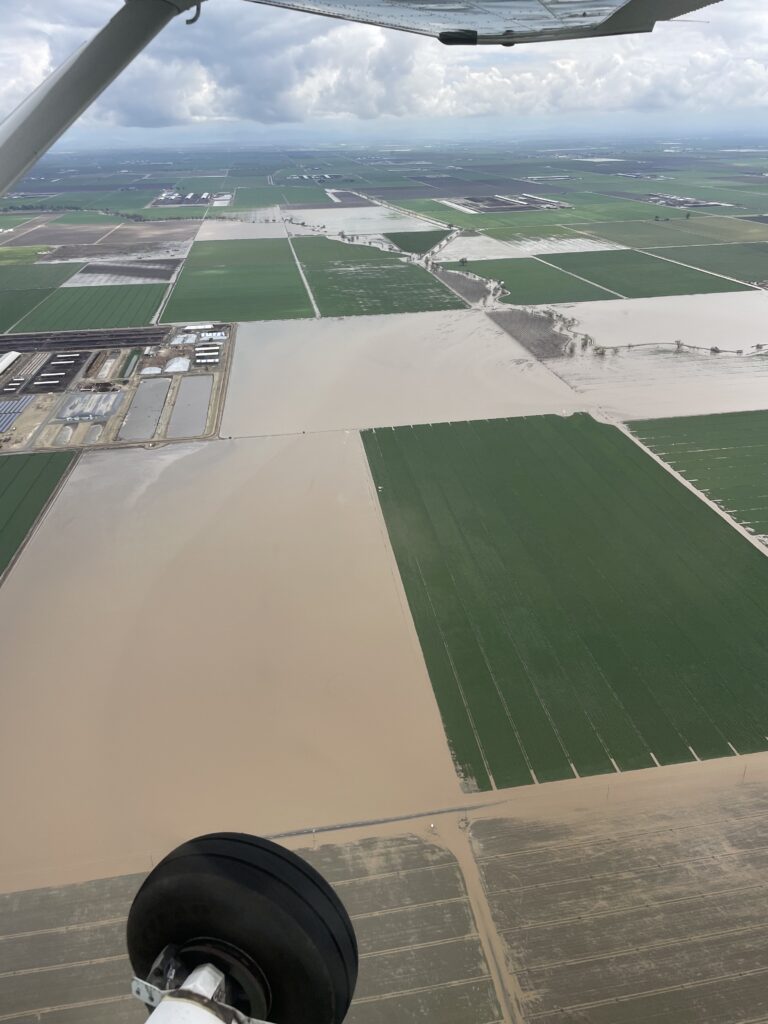When flood water swamped dairies in Tulare and Kings counties last spring, it destroyed equipment, drowned crops and left a trail of salt-laden muck that farmers are still grappling with.
The ongoing damage is so bad, some dairies may never recover.
The biggest problem is the loss of crops and cropland.
Farmers lost an entire year’s worth of wheat, used for feed, that was submerged as the Tule River and other creeks swelled and water gushed over thousands of acres.
That lost crops and cropland, led to a chain of other problems, said Anja Raudabaugh, CEO of Western United Dairies.
The price of wheat skyrocketed, but one of the bigger challenges was where to put all the cow manure
Normally, dairy farmers spread manure on their cropland. Alfalfa, for example, is efficient at uptaking the manure and removing toxins, said Raudabaugh.
But with those crops wiped out, farmers could no longer put the manure on their land and had to pay to have it trucked to fertilizer plants.
The problem isn’t evenly distributed among dairies.
Farms nearer to Highway 99 and the town of Tulare have been back up and running for about six or seven months, Raudabaugh said.
But further west, around Corcoran in the old Tulare Lake, soils are already supercharged with salts and still covered with water. Crops might not be able to grow there for another five years, Raudabaugh said.
“But that’s just too long for most areas to wait because trucking your manure 20 or 30 miles is not a good solution,” said Raudabaugh.
One dairy near the Corcoran State Prison is in the process of closing down permanently, she said. One other is “limping along,” she added.
For the dairies that are still active, the cost has been substantial. Raudabaugh estimates the average economic hit is about $6.5 million per dairy, mostly from lost production.
Federal Emergency Management Agency funding is generally not available to ag operations, said Raudabaugh. Ag losses were quantified and counted toward qualifying Tulare and Kings counties for aid though, she said.
“We’ve never had a disaster of this magnitude,” said Raudabaugh.
About 250,000 cows, or nearly 36% of the 700,000 milk cows in Tulare and Kings counties, had to be evacuated during the flood.
Insurance should cover some of the costs farmers have had to pay out of pocket, said Raudabaugh.
But for some, the losses likely won’t be made up.
Brandon Dykstra has spent about $1.75 million to clean up and get his dairy running again. That cost won’t be covered by insurance, Dykstra said. Dykstra Dairy sits along the Tule River southwest of the City of Tulare. Dykstra owns about 4,000 cows and 1,700 acres of crops.
Dykstra’s wheat crops died from the floods forcing him to buy feed for the cows. He also spent hundreds of thousands of dollars leveling fields and cleaning debris.
Some of his crops that weren’t wiped out are now infected with a pathogen because of the excess of water in the soil. The water also carried in seeds causing weeds to flourish on his land.
Still, Dykstra, partner at Dykstra Dairy, has been able to return to mostly normal operations.
“I would consider us lucky for what happened on all that compared to other people,” said Dykstra.
Another effect of the flood damage will likely be lower tax revenue for Tulare County as well, though firm loss numbers haven’t been calculated yet, said Christopher Greer, assistant agricultural commissioner for Tulare County. Crop reporting and statistics aren’t typically gathered and released until about a year later. The 2022 report came out in the fall of 2023. So it will still be a while before the picture is clear.
The county did extend some tax relief to farmers for flooded lands, said Greer.
“They weren’t going to double whammy (farmers) and make them pay all these taxes on (the land) when there’s nothing producing,” said Greer.
Those lands were assessed at the lowest possible value during the floods, he added. But it’s still unknown how much land remains uncultivated today, said Greer.
Extreme storms are becoming more common due to climate change, changing the agricultural landscape of the valley.
But as long as severe flooding doesn’t become the norm, Dykstra thinks his operation will be just fine.
“I don’t think I can handle a worse one,” said Dykstra. “But if it was a once every 25 to 50 years, we can handle that.”
Share this:
- Click to share on Facebook (Opens in new window)
- Click to share on Twitter (Opens in new window)
- Click to share on LinkedIn (Opens in new window)
- Click to share on Reddit (Opens in new window)
- Click to share on Tumblr (Opens in new window)
- Click to share on Pinterest (Opens in new window)
- Click to share on Pocket (Opens in new window)
- Click to share on Telegram (Opens in new window)
- Click to share on WhatsApp (Opens in new window)
- Click to print (Opens in new window)








